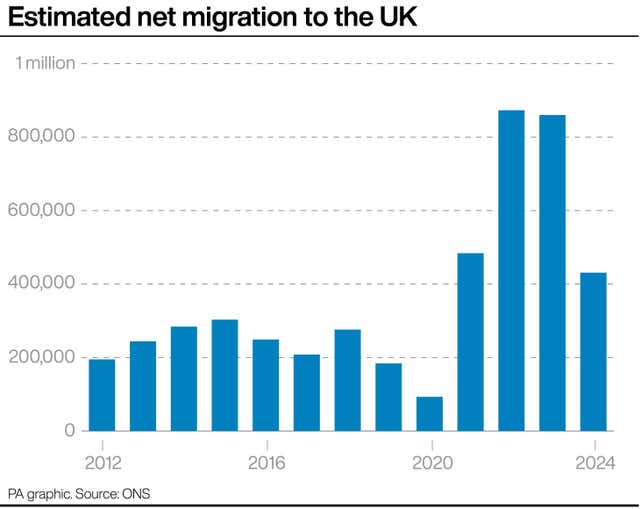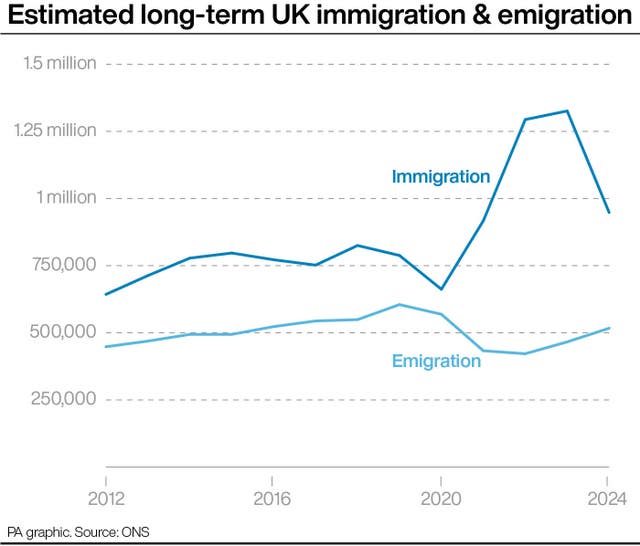What do the latest migration figures show?
The drop has been driven by a fall in the number of people coming to the UK to work and study.

Net migration to the UK has fallen by a record amount for a calendar year, with the number of people emigrating from the country close to levels last seen before the Covid-19 pandemic.
Here the PA news agency looks at the latest migration figures from the Office for National Statistics (ONS):
– What is the latest estimate of net migration?

Estimated net migration to the UK stood at a provisional total of 431,000 in the year to December 2024, down 429,000 (49.9%) from 860,000 in the year to December 2023.
This is the largest numerical drop on record.
The previous biggest calendar-year fall was during the early stages of the pandemic, when net migration dropped from 184,000 in the year ending December 2019 to 93,000 in the year ending December 2020.
Net migration is the difference between the number of people coming to live in the UK long term and the number of people leaving to live in another country.
– How has migration changed in recent years?
Levels of net migration to the UK have varied sharply.
The figure was broadly flat immediately before the Covid-19 pandemic, standing at 208,000 in 2017, 276,000 in 2018 and 184,000 in 2019.
It then dropped to an estimated 93,000 in 2020, when restrictions introduced during the pandemic limited travel and movement.
The total rose steeply to 484,000 in 2021 and 873,000 in 2022, before dropping slightly to 860,000 in 2023.
The 12 months to June 2023 saw net migration hit a record 906,000.
The new estimate of 431,000 for the year to December 2024 suggests levels are returning to those seen in the early years of the pandemic.
– Why did migration rise to record levels?
Several factors were behind the recent increase.
The war in Ukraine led to thousands of people from that country coming to live in the UK through the Government’s resettlement schemes.
A similar scheme has seen British nationals arriving in the UK from Hong Kong, fleeing the security crackdown by the Chinese government.
Pent-up demand for study-related immigration due to Covid-19 travel restrictions also had an impact.
There was a steep jump in the number of international students coming to the UK in the immediate aftermath of the pandemic in 2021 and 2022.
A further factor has been the changes to the UK’s immigration system.
The post-Brexit introduction of new visas for specific kinds of employment – such as the skilled worker visa and the health and care worker visa – boosted the number of people immigrating to the UK for work.
– What has caused the latest drop in net migration?
It is the result of changes both in the number of people coming to the UK (immigrating) and those leaving the country (emigrating).
The drop in immigration has been driven by a fall in the number of non-EU+ nationals coming to the UK to work and study.
Non-EU+ nationals refers to people who are not from the European Union or from Norway, Iceland, Liechtenstein and Switzerland.
There was a 49% decrease in 2024 in non-EU+ nationals arriving in the UK as the main applicant on a work visa, along with a 35% fall in those coming as work dependants.
The number of non-EU+ nationals arriving as main applicants on a study visa dropped by 17%, while there was a much larger fall of 86% in study dependants.
These decreases are likely to reflect changes in migration rules introduced in early 2024 by the previous Conservative government, which included restricting the ability of most international students to bring family members.
Total long-term immigration in 2024 fell below one million for the first time in a calendar year since 2021, with an estimated 948,000 people coming to live in the UK in the 12 months to December, down 29% from a record 1.33 million in 2023.

At the same time, long-term emigration has risen, with 517,000 people leaving the UK in 2024, up from 466,000 in 2023.
This rise in emigration has been driven by an increase in those who originally came to the UK on study-related visas and who are now reaching the end of their courses.
The majority (61%) of non-EU+ nationals who left the UK in 2024 had originally arrived for study-related reasons.
– What nationality are the people coming to the UK?
Non-EU+ nationals accounted for 81% of long-term immigration in 2024, while EU+ nationals made up 13% and British nationals 6%.
This is a major change from the pattern before the UK had left the European Union and also before the Covid-19 pandemic.
In 2019, non-EU+ nationals accounted for 47% of total immigration, while EU+ nationals made up 44% and British nationals 9%.
There were 766,000 non-EU+ nationals who immigrated to the UK in 2024, of which 83% were of working age (between 16 and 64), 16% were children and 1% were aged 65 or over.
The top five most common countries of nationality were Indian (156,000 people, down year-on-year from 277,000); Pakistani (76,000, down from 94,000); Chinese (70,000, down from 77,000); Nigerian (52,000, down from 165,000); and Ukrainian (23,000, down from 40,000).





